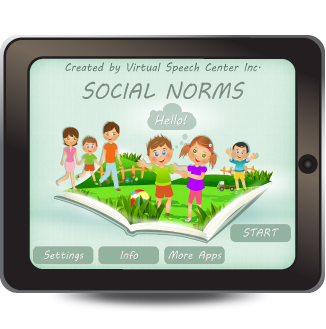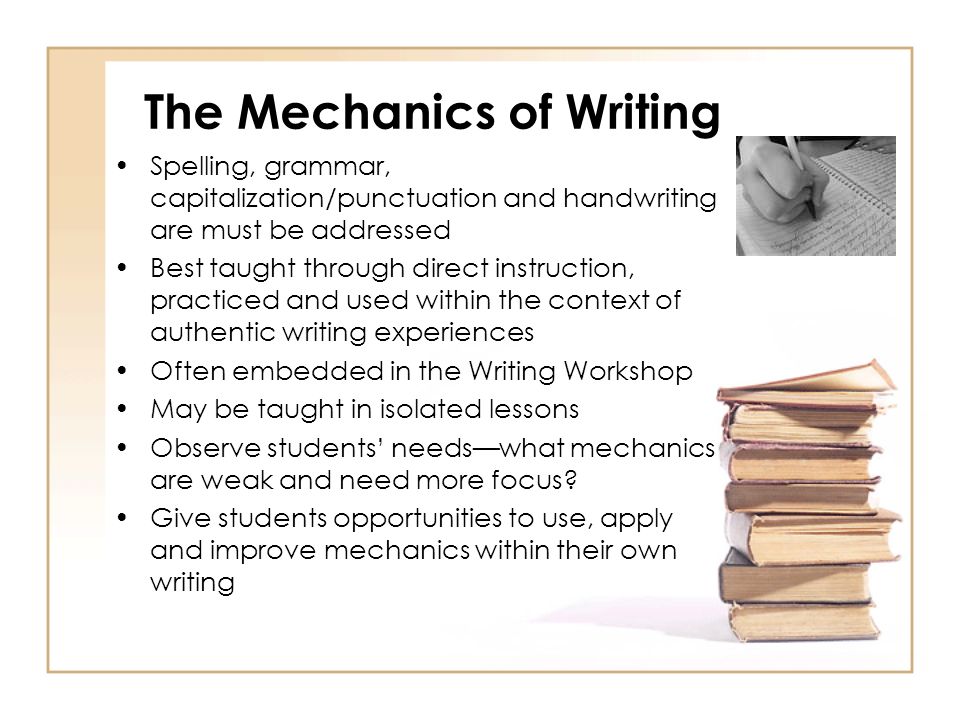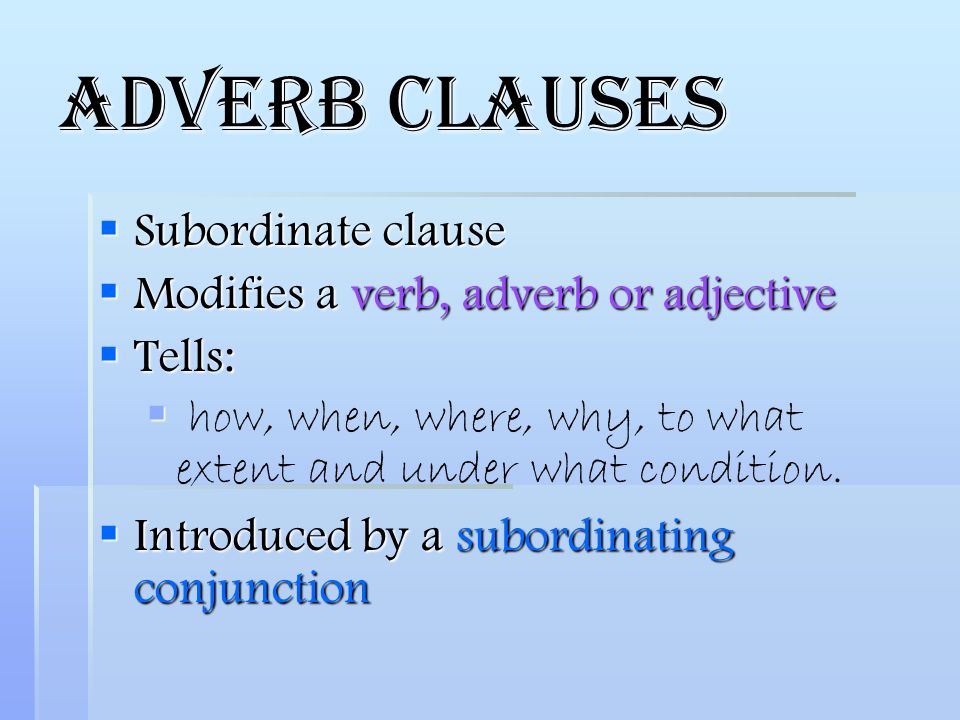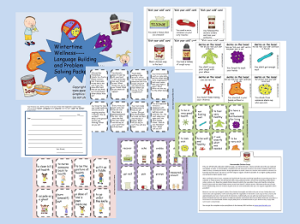 Today I am reviewing “Social Norms” a brand new app developed by the Virtual Speech Center to improve social skills in children with autism spectrum disorders.
Today I am reviewing “Social Norms” a brand new app developed by the Virtual Speech Center to improve social skills in children with autism spectrum disorders.
This app can be used by parents, educators, and SLPs. The users can customize it to add their photos, text, and audio to create individualized stories that teach specific skills to children with ASD with significantly impaired language abilities. It includes 53 stories on the following topics: Continue reading App Review and Giveaway: Social Norms
Search Results for: between the lines
Revised: Speech Language Assessment and Treatment of Children with Alcohol Related Disorders

Introducing a New Series for SLPs and Parents: Spotlight on Syndromes
 Today I am excited to introduce to you the new series which will be featured on my blog and will be written by myself as well as numerous knowledgeable contributing authors. It is an SLP’s perspective on genetic syndromes.
Today I am excited to introduce to you the new series which will be featured on my blog and will be written by myself as well as numerous knowledgeable contributing authors. It is an SLP’s perspective on genetic syndromes.
Why syndromes you ask?
Because speech language pathologists in a variety of settings (e.g., schools, hospitals, private practice, etc.) often encounter children with diagnosed or suspected syndromes. Yet the knowledge regarding various syndromes and their effects on communication continues to remain very limited in our field. Continue reading Introducing a New Series for SLPs and Parents: Spotlight on Syndromes
Winter Non-Fiction Leveled Reading Passages and Questions Product Swap and Giveaway
Today I am doing a product swap and giveaway with Sharon Schackmann, the author of the Speech with Sharon blog, who’s created a product entitled: Winter Non-Fiction Leveled Reading Passages and Questions with a focus on teaching non-fiction text to older students: elementary through -high school ages.
This mega sized 44 page packet includes 7 passages on a variety of winter related topics including: Continue reading Winter Non-Fiction Leveled Reading Passages and Questions Product Swap and Giveaway
Guest Post: Forming and Cultivating Positive Relationships with Middle School Students
 Today’s guest post on working with middle school students comes from Zoya Tsirulnikov, MS CCC-SLP, TSSLD , an SLP from the NYC’s Department of Education.
Today’s guest post on working with middle school students comes from Zoya Tsirulnikov, MS CCC-SLP, TSSLD , an SLP from the NYC’s Department of Education.
The middle school population is fun and exciting to work with, however it may prove to be quite challenging for some SLPs. This is my fifth year working for the New York City Department of Education at the Middle School level. I started out working with high school and elementary school students and quickly realized that this particular age group is different from its younger and older counterparts. Whereas at the elementary grades, students are learning new skills and concepts and building the foundation for expository text, the middle school students are expected to have bridged over to more rigorous text. Therefore, the achievement gap is very noticeable since students are tackling more de-contextualized discourse. Continue reading Guest Post: Forming and Cultivating Positive Relationships with Middle School Students
Birthday Giveaway Day Nineteen: Food Category Sorting
 Today’s giveaway Food Category Sorting is brought to you courtesy of The Speech Summit.
Today’s giveaway Food Category Sorting is brought to you courtesy of The Speech Summit.
This cute 26 page activity involves sorting: fruits, vegetables, desserts, meat, and drinks.
It includes:
picnic boards to sort each categories
food items on 3 ½ x 3′ cards
picnic themed game boards
pages of food themed tokens
An interactive game which targets category sorting and vocabulary building activities is also included. For those who don’t want to use the game you can use food cards and picnic boards for strengthening listening comprehension and verbal expression by sorting the food items into the correct categories as well as naming items in correct categories. You can find this item in Speech Summit’s TPT store HERE or you can enter below for a chance to win your copy.
a Rafflecopter giveaway
Components of Qualitative Writing Assessments: What Exactly are We Trying to Measure?
Writing! The one assessment area that challenges many SLPs on daily basis! If one polls 10 SLPs on the topic of writing, one will get 10 completely different responses ranging from agreement and rejection to the diverse opinions regarding what should actually be assessed and how exactly it should be accomplished.
Consequently, today I wanted to focus on the basics involved in the assessment of adolescent writing. Why adolescents you may ask? Well, frankly because many SLPs (myself included) are far more likely to assess the writing abilities of adolescents rather than elementary-aged children.
Often, when the students are younger and their literacy abilities are weaker, the SLPs may not get to the assessment of writing abilities due to the students presenting with so many other deficits which require precedence intervention-wise. However, as the students get older and the academic requirements increase exponentially, SLPs may be more frequently asked to assess the students’ writing abilities because difficulties in this area significantly affect them in a variety of classes on a variety of subjects.
So what can we assess when it comes to writing? In the words of Helen Lester’s character ‘Pookins’: “Lots!” There are various types of writing that can be assessed, the most common of which include: expository, persuasive, and fictional. Each of these can be used for assessment purposes in a variety of ways.
To illustrate, if we chose to analyze the student’s written production of fictional narratives then we may broadly choose to analyze the following aspects of the student’s writing: contextual conventions and writing composition.
 The former looks at such writing aspects as the use of correct spelling, punctuation, and capitalization, paragraph formation, etc.
The former looks at such writing aspects as the use of correct spelling, punctuation, and capitalization, paragraph formation, etc.
The latter looks at the nitty-gritty elements involved in plot development. These include effective use of literate vocabulary, plotline twists, character development, use of dialogue, etc.
Perhaps we want to analyze the student’s persuasive writing abilities. After all, high school students are expected to utilize this type of writing frequently for essay writing purposes. Actually, persuasive writing is a complex genre which is particularly difficult for students with language-learning difficulties who struggle to produce essays that are clear, logical, convincing, appropriately sequenced, and take into consideration opposing points of view. It is exactly for that reason that persuasive writing tasks are perfect for assessment purposes.
But what exactly are we looking for analysis wise? What should a typical 15 year old’s persuasive essays contain?
 With respect to syntax, a typical student that age is expected to write complex sentences possessing nominal, adverbial, as well as relative clauses.
With respect to syntax, a typical student that age is expected to write complex sentences possessing nominal, adverbial, as well as relative clauses.
With the respect to semantics, effective persuasive essays require the use of literate vocabulary words of low frequency such as later developing connectors (e.g., first of all, next, for this reason, on the other hand, consequently, finally, in conclusion) as well as metalinguistic and metacognitive verbs (“metaverbs”) that refer to acts of speaking (e.g., assert, concede, predict, argue, imply) and thinking (e.g., hypothesize, remember, doubt, assume, infer).
With respect to pragmatics, as students mature, their sensitivity to the perspectives of others improves, as a result, their persuasive essays increase in length (i.e., total number of words produced) and they are able to offer a greater number of different reasons to support their own opinions (Nippold, Ward-Lonergan, & Fanning, 2005).
Now let’s apply our knowledge by analyzing a writing sample of a 15-year-old with suspected literacy deficits. Below 10th-grade student was provided with a written prompt first described in the Nippold, et al, 2005 study, entitled: “The Circus Controversy”. “People have different views on animals performing in circuses. For example, some people think it is a great idea because it provides lots of entertainment for the public. Also, it gives parents and children something to do together, and the people who train the animals can make some money. However, other people think having animals in circuses is a bad idea because the animals are often locked in small cages and are not fed well. They also believe it is cruel to force a dog, tiger, or elephant to perform certain tricks that might be dangerous. I am interested in learning what you think about this controversy, and whether or not you think circuses with trained animals should be allowed to perform for the public. I would like you to spend the next 20 minutes writing an essay. Tell me exactly what you think about the controversy. Give me lots of good reasons for your opinion. Please use your best writing style, with correct grammar and spelling. If you aren’t sure how to spell a word, just take a guess.”(Nippold, Ward-Lonergan, & Fanning, 2005)
He produced the following written sample during the allotted 20 minutes.
Analysis: This student was able to generate a short, 3-paragraph, composition containing an introduction and a body without a definitive conclusion. His persuasive essay was judged to be very immature for his grade level due to significant disorganization, limited ability to support his point of view as well as the presence of tangential information in the introduction of his composition, which was significantly compromised by many writing mechanics errors (punctuation, capitalization, as well as spelling) that further impacted the coherence and cohesiveness of his written output.
The student’s introduction began with an inventive dialogue, which was irrelevant to the body of his persuasive essay. He did have three important points relevant to the body of the essay: animal cruelty, danger to the animals, and potential for the animals to harm humans. However, he was unable to adequately develop those points into full paragraphs. The notable absence of proofreading and editing of the composition further contributed to its lack of clarity. The above coupled with a lack of a conclusion was not commensurate grade-level expectations.
 Based on the above-written sample, the student’s persuasive composition content (thought formulation and elaboration) was judged to be significantly immature for his grade level and is commensurate with the abilities of a much younger student. The student’s composition contained several emerging claims that suggested a vague position. However, though the student attempted to back up his opinion and support his position (animals should not be performing in circuses), ultimately he was unable to do so in a coherent and cohesive manner.
Based on the above-written sample, the student’s persuasive composition content (thought formulation and elaboration) was judged to be significantly immature for his grade level and is commensurate with the abilities of a much younger student. The student’s composition contained several emerging claims that suggested a vague position. However, though the student attempted to back up his opinion and support his position (animals should not be performing in circuses), ultimately he was unable to do so in a coherent and cohesive manner.
Now that we know what the student’s written difficulties look like, the following goals will be applicable with respect to his writing remediation:
Long-Term Goals: Student will improve his written abilities for academic purposes.
- Short-Term Goals
- Student will appropriately utilize parts of speech (e.g., adjectives, adverbs, prepositions, etc.) in compound and complex sentences.
- Student will use a variety of sentence types for story composition purposes (e.g., declarative, interrogative, imperative, and exclamatory sentences).
- Student will correctly use past, present, and future verb tenses during writing tasks.
- Student will utilize appropriate punctuation at the sentence level (e.g., apostrophes, periods, commas, colons, quotation marks in dialogue, and apostrophes in singular possessives, etc.).
- Student will utilize appropriate capitalization at the sentence level (e.g., capitalize proper nouns, holidays, product names, titles with names, initials, geographic locations, historical periods, special events, etc.).
- Student will use prewriting techniques to generate writing ideas (e.g., list keywords, state key ideas, etc.).
- Student will determine the purpose of his writing and his intended audience in order to establish the tone of his writing as well as outline the main idea of his writing.
- Student will generate a draft in which information is organized in chronological order via use of temporal markers (e.g., “meanwhile,” “immediately”) as well as cohesive ties (e.g., ‘but’, ‘yet’, ‘so’, ‘nor’) and cause/effect transitions (e.g., “therefore,” “as a result”).
- Student will improve coherence and logical organization of his written output via the use of revision strategies (e.g., modify supporting details, use sentence variety, employ literary devices).
- Student will edit his draft for appropriate grammar, spelling, punctuation, and capitalization.
There you have it. A quick and easy qualitative writing assessment which can assist SLPs to determine the extent of the student’s writing difficulties as well as establish writing remediation targets for intervention purposes.
Using a different type of writing assessment with your students? Please share the details below so we can all benefit from each others knowledge of assessment strategies.
References:
- Nippold, M., Ward-Lonergan, J., & Fanning, J. (2005). Persuasive writing in children, adolescents, and adults: a study of syntactic, semantic, and pragmatic development. Language, Speech, and Hearing Services in Schools, 36, 125-138.
Wintertime Wellness Product Swap and Giveaway
 Today I am doing a product swap and giveaway with Rose Kesting of Speech Snacks. Rose runs a fun and unique blog. In her posts she combines her interest in nutrition and healthy cooking with her professional knowledge as a speech-language pathologist. I’ve collaborated with Rose in the past on a variety of projects and have always been impressed with the quality of her speech and language products, which are typically aimed at language remediation of older children (upper-elementary, middle school and high school ages). Continue reading Wintertime Wellness Product Swap and Giveaway
Today I am doing a product swap and giveaway with Rose Kesting of Speech Snacks. Rose runs a fun and unique blog. In her posts she combines her interest in nutrition and healthy cooking with her professional knowledge as a speech-language pathologist. I’ve collaborated with Rose in the past on a variety of projects and have always been impressed with the quality of her speech and language products, which are typically aimed at language remediation of older children (upper-elementary, middle school and high school ages). Continue reading Wintertime Wellness Product Swap and Giveaway
If you give a mouse a cookie, it will want some phonemic awareness to go with it

I love book companion packs! Honestly I can’t get enough of them!
One of the reasons I particularly enjoy using them is because they nicely supplement thematic language therapy activities (see Twin Sister’s Post HERE on thematic therapy). This is why I jumped at the opportunity to review Speech Universe’s If You Give A Mouse A Cooke Phonemic Awareness Packet.
Phonemic Awareness activities are incredibly important for young (Pre-K-1st grade) language impaired learners. They are especially important for children from low SES households as well as young limited English proficiency learners.
Jen’s packet is terrific at addressing a number of phonemic awareness skills including:
- Syllable Counting
- Rhyme Recognition
- Rhyme Generation
- Syllable Blending and
- Initial Sound Isolation Continue reading If you give a mouse a cookie, it will want some phonemic awareness to go with it
Real Vocabulary App Review and Giveaway
Today I am a reviewing a new vocabulary app created by the Virtual Speech Center called Real Vocabulary Pro. Developed to target the core curriculum vocabulary of K-5th grade students, it has tons tons of pictures and pre-recorded audio to target various vocabulary concepts as well as allows users to add their own words, pictures and audio recordings for a more individualized and targeted therapy sessions. Continue reading Real Vocabulary App Review and Giveaway
